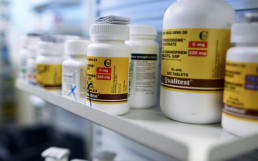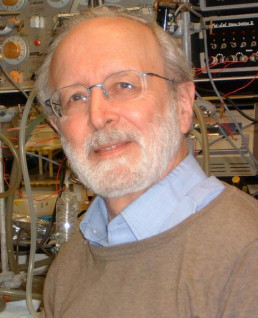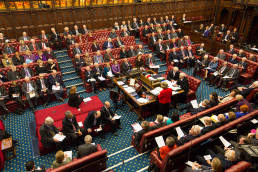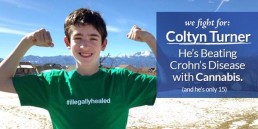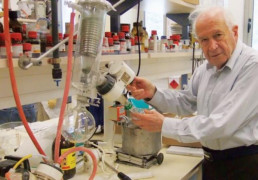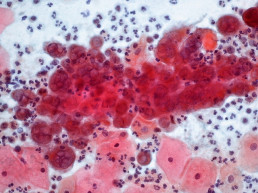Can Medical Cannabis and Opioids be used together?
Can Medical Cannabis and Opioids be used together?
With 23 states (and Washington D.C.) having already legalized medical marijuana, the time has come when physicians are finally able to prescribe it for pain management, instead of opioids or in combination with them.
Having an alternative to opioids is an important step for patients suffering from chronic pain as these are known to be highly addictive. More importantly, with new laws that enable access to marijuana for medical purposes, mortality rates from opioid overdoses have lowered in states that legalized medical cannabis. However, because of the lack of adequate research about marijuana, many physicians are concerned about its effects in combination with opioids.
An interesting new study was published in the May issue of the Journal of Studies on Alcohol and Drugs. The study examined nearly 280 patients who have been receiving medical marijuana at a clinic in Michigan. More than half of them were using it in combination with opioids. The study found that using opioids in combination with cannabis does not increase substance abuse risk – the rate of co-occurring substance use between those medical marijuana users who combined it with opioids and those who did not was almost the same; there were no significant differences.
Lead study authour Brian Perron stated;
“In states where medical marijuana is legal, physicians should be aware that medical marijuana is a potentially safer and more effective treatment approach than opioids.”
His team of researchers is now looking into expanding their study over the course of two years, to discover if time has anything to do with development of substance abuse.
Opioid use in America has reached a point when it is being considered as an epidemic. The chronic misuse of pain medication is a result of easy access and more importantly, there was no other alternative to opioids…until now.
The Center for Disease Control reports that nearly 17,000 people die every year from an opioid overdose. Hopefully, our lawmakers will soon come to agreement and realize that marijuana my be the most proficient alternative.
Australian State Commits $9m to Medical Cannabis Research
Australian State Commits $9m to Medical Cannabis Research
Today, the New South Wales government has pledged $9 million for medical marijuana trials in the state.
The $9 million, which will be paid over 4 years will fund trials involving children with severe epilepsy, patients undergoing chemotherapy and adults with terminal illnesses.
In another exciting move for Australia, two other state governments have revealed that they will soon be following New South Wales in medical marijuana funding. Queensland and Victoria have pledged to commit money to further research into the medical benefits of cannabis.
Australia’s Medical Research Minister Pru Goward told the press;
“Medical research unlocks new treatment for disease, offers hope, delivers cures, keeps people well and out of hospital. At its best [it] profoundly improves lives.”
Australia made headlines earlier this year, when Sydney millionaire Barry Lambert donated $33.7 million to the University of Sydney for more research to be conducted on the therapeutic benefits of cannabis. Lambert credits medical cannabis for saving the life of his 3-year-old epileptic granddaughter.
An Exclusive Interview with Professor Roger Pertwee
An Exclusive Interview with Professor Roger Pertwee
When someone is coveted with the same prestigious award as 3 Nobel Prize winners and 16 Fellows of the Royal Society, it is abundantly clear that their contribution to their profession is significant to say the least.
This can be said of Professor Roger Pertwee, who in 2011 was awarded the Wellcome Gold Medal from the British Pharmacological Society for his contribution to Pharmacology and ground-breaking research into cannabinoids.
Having spent most of his professional career based at the University of Aberdeen, Pertwee and his associates have made a significant number of breakthrough discoveries concerning cannabinoids over the last half century, leading to collaborations with some of the worlds most coveted medical professionals, including “The Father of Cannabis” Raphael Mechoulam.
An international figure head for cannabis based research, Pertwee works alongside countless notable societies and foundations including GW Pharmaceuticals, the International Union of Pharmacology, the International Cannabinoid Research Society, the International Association for Cannabinoid Medicines and the Beckley Foundation.
This month, Medical Marijuana had the opportunity to speak with Pertwee regarding his 4 decades worth of research into cannabinoids and his opinion on the current state of cannabis and its potential therapeutic benefits:
The academic research of cannabinoids has come a long way in the past 60 years, which events and findings do you feel are the most outstanding over this period?
(a) The discovery of presence of THC in cannabis, of its structure (in 1964), and that it is the main psychoactive constituent of cannabis.
(b) The development of synthetic cannabinoids as medicines (nabilone and marinol).
(c) The discovery of cannabinoid receptors.
(d) The discovery of endogenous cannabinoids (endocannabinoids) – and hence of the endocannabinoid system.
(e) The discovery that this system plays important roles in both health and disease.
(f) The discovery that cannabinoid receptors have allosteric as well as orthosteric sites.
(g) The discovery that cannabis/certain phytocannabinoids are effective vs multiple sclerosis.
(h) The development of a cannabis-based medicine (Sativex) – encouraged by the House of Lords Select Committee on Science and Technology (1998).
(i) New pharmacological information of potential clinical importance about phytocannabinoids other than THC.
(j) The development of CB1 and CB2 selective agonists and antagonists – i.e. of drugs that are much more potent at activating or blocking CB1 than CB2 receptors – or that are much more potent at activating or blocking CB2 than CB1 receptors.
What are your views concerning individual cannabinoids and whole plant extracts? Can you please explain why whole plant extracts containing cannabinoids & terpenes may be more efficient (pharmacologically) than individual cannabinoids?
Pharmacological actions of only a few of the phytocannabinoids that are known to be present in cannabis have now been discovered. Even so, this has helped to identify a number of potential new therapeutic applications for these compounds when given by themselves or with one or more other phytocannabinoid(s). There is some preclinical data which suggests that one potential strategy for pain relief, might be the co-administration of THC and cannabigerol.
There is also a lot of preclinical evidence that medicines could be developed from drugs that modulate (a) the levels of endocannabinoids in the body or (b) the ability of endocannabinoids to activate cannabinoid receptors following their endogenous release.
Under current UK legislation, cannabis and extracts of cannabis are class B drugs in schedule 1 of the misuse of drugs act, this deems them to have “no medicinal value”. To what degree do you believe the current scheduling of cannabis in the UK and around the world has hindered research, and in turn human health/survival? Was this scheduling ever justified in your opinion?
The problem is the recreational use of cannabis – UK legislation should perhaps treat recreational cannabis and medicinal cannabis/cannabinoids differently.
How many cannabinoids have been identified? And do you think there are more waiting to be discovered?
Cannabis contains at least 104 “phytocannabinoids” plus at least 441 other compounds. It is likely that more compounds will be discovered in at least some strains of cannabis. See also Pertwee’s publication Handbook of Cannabis (Handbooks in Psychopharmacology)
Which cannabinoid do you believe offers the most medicinal benefits?
There is no single plant cannabinoid that offers the most medicinal benefits as cannabis is the source of several compounds that show equally high potential as medicines for one disorder or another. These phytocannabinoids include: tetrahydrocannabinol (THC), cannabidiol (CBD), tetrahydrocannabivarin (THCV) and cannabigerol (CBG). Please note however, that we know very little about the pharmacology/toxicology of most of the phytocannabinoid and non-phytocannabinoid constituents of cannabis.
Many cannabis based medicines and preparations are produced to treat symptoms of illnesses and disease. Do you think that in the future cannabinoids may also offer some preventative opportunities, e.g. in being widely prescribed like such drugs as statins?
Currently, the main cannabis-based medicine is Sativex. There is evidence (e.g. from preclinical research) that as well as ameliorating the signs and symptoms of multiple sclerosis, it may slow the progression of this disorder.
In your opinion, is raw well grown cannabis, and cannabis extractions safe enough now for use without full clinical trials, if prescribed correctly?
Full clinical trials with all previously untested cannabis or cannabis extracts should always be carried out as the chemical content of cannabis/cannabis extracts can vary considerably.
What effects do you think cannabinoid based medicines would have on the existing pharmaceutical industry if they were easier to access? Which particular illness or diseases do you feel will be more effectively treated with cannabinoids?
They are likely to affect the pharmaceutical industry more after additional clinical data have been obtained from new clinical trials. Preclinical data predict very many clinical targets for one or more phytocannabinoids –e.g. epilepsy, schizophrenia (including negative symptoms), depression, eye disorders, gastrointestinal disorders, stroke, diabetic nephropathy, neurodegenerative disorders such as Parkinson’s disease, obesity, diabetes, drug dependence (e.g. nicotine dependence), atherosclerosis, osteoporosis, post-traumatic stress disorder, hypertension, Tourette syndrome, nausea and vomiting, cancer etc etc etc. The need now is for some clear clinical data.
Have there been any anecdotal stories you have heard regarding cannabis based medicines that have really surprised you?
Yes – particularly about multiple sclerosis back in the 1980’s and 1990’s – see my contribution to “The Medicalization of Cannabis. Witness Seminar Transcript. Volume 40. The Wellcome Trust Centre for the History of Medicine, at UCL.”
See also my contribution to the Report on Cannabis by the House of Lords Select Committee on Science and Technology (1998).
I actually co-authored a paper based on some anecdotal stories/claims about cannabis and multiple sclerosis. See “The perceived effects of cannabis smoking in patients with multiple sclerosis”.
I think anecdotal stories regarding cannabis based medicines/medical marijuana should not be ignored as they may well lead to the identification of important disorders that could best be treated with a cannabis-based medicine.
If you received a diagnosis of cancer would you be tempted to introduce or to use cannabinoids in your personal treatment regime?
Not without more clinical data – and then probably only using a licensed cannabinoid medicine.
The Handbook of Cannabis (Handbooks in Psychopharmacology) edited by Roger Pertwee is available to purchase now.
Obama Administration Change Laws, Medical Marijuana Research Now Easier
Obama Administration Change Laws, Medical Marijuana Research Now Easier
Today, the Obama administration have altered a 4-point ruling on medical marijuana, making research into its therapeutic properties much easier.
According to the Washington Post, before today privately funded medical marijuana research needed to adhere to the following steps;
1. Submit your study proposal to the Food and Drug Administration for a thorough review of its “scientific validity and ethical soundness.”
2. Submit your proposal to a separate Public Health Service (PHS) board, which performs pretty much the exact same review as the FDA.
3. Get a marijuana permit from the Drug Enforcement Administration.
4. Finally, obtain a quantity of medical marijuana via the Drug Supply Program run by the National Institute on Drug Abuse (NIDA), which maintains a monopoly on medical marijuana grown for research in the U.S.
Step 2 has been a cause for concern amongst advocates and members of congress for some time now, deeming the PHS review redundant. The Obama administration today agreed with this, and effective immediately, medical marijuana researchers will no longer have to submit their proposal to the PHS board.
Tom Angell of Marijuana Majority, a pro-legalization group said to the Post;
The president has often said that drug policy should be dictated by unimpeded science instead of ideology, and it’s great to see the Obama administration finally starting to take some real action to back that up.
Former Nurse takes Medical Cannabis fight to the House of Lords
Former Nurse takes Medical Cannabis fight to the House of Lords
A former nurse is fighting for her right to medicinal cannabis, and her argument has been taken all the way to the House of Lords.
Lara Smith, a former paediatric nurse and now a member of the drug policy reform group CLEAR, has spinal arthritis and her only source of pain relief is Bedrocan. However, Smith has to travel to Holland every three months, running a “customs gauntlet” in order to obtain her medicine.
Today, after campaigns from the likes of Lara Smith, the House of Lords will be listening to a series of experts discuss how access to medical cannabis could help thousands of people suffering from MS, arthritis and a host of other ailments.
Cannabis remains a Schedule 1 drug under the Misuse of Drugs Regulations 2001 act, which means the Government consider it to have no medicinal value.
Speaking to the media, Smith stated;
Having a medicine that works makes a massive difference. I certainly don’t cry as much as I used to. I’ve got less pain and I’m more tolerant and able, and I can sit down with my children with a clarity of mind to help them with their homework. The All Party Parliamentary Group for Drug Policy Reform say it should be a Schedule 2 medicine and I should be allowed to import it. I’ve pushed really hard to get this medicine, but it’s more important for the people that currently don’t have access to it. When it gets to the point that you can’t put your own socks on you’re in so much pain it gets beyond a joke.
Smith has recieved support from her local MP, as well as former Home Office Minister Norman Baker.
The case will be presented today at 3pm GMT.
All Forms of Medical Marijuana Legal in Canada
All Forms of Medical Marijuana Legal in Canada
The Supreme Court in Canada has ruled that Medical marijuana patients can now legally use all forms of the drug, not only smoke it. Previously, regulations under the Controlled Drugs and Substances Act, S.C. 1996, c. 19 (“CDSA”), only permitted the use of marijuana for treating medical conditions to “dried marijuana”, so that those who were legally authorized to possess marijuana for medical purposes were still prohibited from possessing cannabis products extracted from the active medicinal compounds in the cannabis plant.
The decision comes after the case was taken to court in 2009 by Owen Smith, who had been producing edible and topical marijuana derivatives for sale by extracting the active compounds from the cannabis plant. The Club sold marijuana and cannabis derivative products to members: people the Club was satisfied had a bona fide medical condition for which marijuana might provide relief, based on a doctor’s diagnosis or laboratory test. It sold not only dried marijuana for smoking, but edible and topical cannabis products; cookies, gel capsules, rubbing oil, topical patches, butters and lip balms. However, he operated outside the Marijuana Medical Access Regulations (“MMARs”), which limited lawful possession of medical marijuana to dried marijuana. The police charged him with possession and possession for purpose of trafficking of cannabis.
The defendant argued that inhaling marijuana, typically through smoking, provides quick access to the medical benefits of cannabis, but also has harmful side effects. Although less harmful than tobacco smoke, smoking marijuana presents acknowledged risks, as it exposes patients to carcinogenic chemicals and is associated with bronchial disorders. Despite this, the active compounds of the cannabis plant, such as THC and cannabidiol, have established medical benefits and their therapeutic effect is generally accepted, although the precise basis for the benefits has not yet been established. Moreover, Mr Smith insisted on the fact that different methods of administering marijuana offer different medical benefits. For example, oral ingestion of the active compounds, whether by way of products baked with THC-infused oil or butter, or gel capsules filled with the active compounds, may aid gastro-intestinal conditions by direct delivery to the site of the pathology. Furthermore, oral administration results in a slower build-up and longer retention of active compounds in the system than inhaling, allowing the medical benefits to continue over a longer period of time, including while the patient is asleep. It is therefore more appropriate for chronic conditions.
All in all, the accused managed to convince the judge by appealing to the Court to determine whether restricting medical access of marijuana to dried marijuana violated s. 7 of the Charter:
Everyone has the right to life, liberty and security of the person and the right not to be deprived thereof except in accordance with the principles of fundamental justice.
The accused argued that the prohibition on possession of non‑dried forms of medical marijuana limited the s. 7 Charter right to liberty of the person. He argued that the prohibition deprived medical marihuana users of their liberty by imposing a threat of imprisonment on conviction under s. 4(1) or 5(2) of the CDSA. Secondly, he said that it limited the liberty of medical users by foreclosing reasonable medical choices through the threat of criminal prosecution. By forcing a person to choose between a legal but inadequate treatment and an illegal but more effective one, the law also infringed the security of the person.
Therefore, the trial judge found that the restriction to dried marijuana deprived Mr. Smith and medical marijuana users of their liberty by imposing a threat of prosecution and incarceration for possession of the active compounds in cannabis. He also found that it deprived medical users of the liberty to choose how to take medication they are authorized to possess, a decision which he characterized as “of fundamental personal importance”, contrary to s. 7 of the Charter.
Child using Cannabis Oil says, ‘I’d Rather Be Illegally Alive Than Legally Dead’
Child using Cannabis Oil says, ‘I’d Rather Be Illegally Alive Than Legally Dead’
A 15-year old boy has spoken in public about his use of cannabis oil to treat his Crohn’s disease, stating “I’d rather be illegally alive, than legally dead”.
Coltyn Turner’s case was just one of a number of reports that were presented at the National Jewish Health’s Marijuana and Health Symposium in Colorado in June.
Turner, who has been using oil for just 10 months after his parents moved from the Midwest to Denver in search of a cure, told the Symposium;
“I was just on every pharmaceutical there was out there until I would up in a wheelchair.”
However, his use of cannabis oil has halted his rapid decline and his parents believe that patients like Coltyn should be allowed access to cannabis oil immediately and not just as a last resort.
His mother Wendy stated, “We want people to understand that this is a good option”.
The Father of Cannabis: Raphael Mechoulam and Cannabinoids
The Father of Cannabis: Raphael Mechoulam and Cannabinoids
As a smiling 84-year old lecturer at the Hebrew University of Jerusalem, interacting with young students on a daily basis, Raphael Mechoulam doesn’t appear to stand out from the crowd. To the everyday man, he is simply part of the faculty at one of the most respected educational facilities in Israel.
However, the Bulgarian born professor is perhaps the most prominent figure in the world of cannabis research; his ground breaking discoveries in the 1960’s are the basis for every single piece of research conducted today. Mechoulam has, albeit indirectly, potentially saved the lives of thousands through his life’s work and is still known to this day as the “Father of Cannabis”.
In an 2012 interview with NoCamels.com, Mechoulam stated that as a young student at the Weizmann Institute in Israel, he wanted to find an ‘important topic of research’ that had yet been studied. He noted that the “active compound in morphine had been isolated from opium 100 years before and cocaine had been isolated from cocoa leaves at the same time, yet the active compounds in marijuana were unknown”.[ref]http://nocamels.com/2013/09/professor-raphael-mechoulam-the-father-of-marijuana-research-talks-to-nocamels-about-his-studies-and-breaking-the-law-in-the-name-of-science/[/ref]
In 1963, Mechoulam acquired marijuana illegally and began to de-construct the plant with a team of scientists. It did not take long before the then 32-year-old had managed to isolate CBD, a non-pyschoactive compound in cannabis.
Having been turned down by the National Institute of Health, with them stating that “Marijuana is not America’s problem”, Mechoulam continued to work unfunded to discover what other compounds made up the plant.
By 1964, the National Institute of Health had permitted Mechoulam and his staff to research further. This turn around in opinion by the NIH came via a request from a US Senator, who caught his son smoking cannabis and demanded to know how the psychoactive compounds could affect the human body.
After a further year’s work, Mechoulam had managed to isolate tetrahydrocannabinol for the first time in history, naming it the key psychoactive compound in cannabis. When Mechoulam notified the NIH of his discovery, his entire supply of THC was taken from him for further studies in America. Mechoulam was given a grant for his research and compliance, which he still holds to this day.
Despite his major scientific discovery being taken away from him, Mechoulam refused to halt research, instead turning to the human body rather than the cannabis plant.
Over the following years, Mechoulam and his team discovered key components of the endocannabinoid system. Firstly, two of his postdoctoral researchers discovered Anandamide, an endogenous cannabinoid neurotransmitter that directly interacts with CB receptors in the human body. Another enogenous cannabinoid, 2-Arachidonoylglycerol (2-AG) was then discovered by one of Mechoulam’s PHD students.
Over the past 50 years, it is almost impossible to count just how many breakthrough discoveries in cannabinoids and the endocannabinoid system can be attributed to Mechoulam and his team. However, with countless awards, 350 publications and thousands of hours spent in the laboratory, it is safe to say that Ralph Mechoulam deserves to be celebrated as the single greatest cannabis researcher in history.
New Zealand Teenager in Coma Approved for Cannabis Product on "Compassionate Grounds"
A New Zealand teenager who has been in an induced coma for two months has been approved for one-off cannabis treatment on ‘compassionate grounds’.
Alex Renton, 19, developed an unknown condition that caused him to suffer repeated seizures. After being placed in an induced coma for nearly 60 days, New Zealand’s Associate Minister of Health Peter Dunne has permitted the use of Elixinol after all other treatments have failed. Elixinol is an oil extracted from Industrial Hemp plants (stalks and seeds). The plants used are specially bred to contain high concentrations of the naturally occurring Cannabinoid Cannabidiol (CBD); Elixinol contains 18% CBD.
Dunne stated to the media;
“Despite the absence of clinical evidence supporting the efficacy of CBD in patients with Mr Renton’s condition status epilepticus, my decision relies on the dire circumstances and extreme severity of Mr Renton’s individual case. Understandably they (Renton’s parents) want to do the best for their son, and they believe that this option is worth trying.”
Despite permitting the use of a CBD product for the Wellington based teenager, Dunne was quick to point out that this is a one-off circumstance and should in no way be “construed as setting a wider precedent” regarding New Zealand and their stance on cannabis based medicine.
How Herpes is Affected by THC, as Explained by Dr. Rasmussen
How Herpes is Affected by THC, as Explained by Dr. Rasmussen
I remember years ago a patient telling me that he cured a “cancerous” lesion on his dog’s leg using cannabis oil. At the time I thought it was fanciful and interesting but probably coincidental at best.
However, it appears that the topical use of cannabis oil (CO) may indeed be curative in many dermatologic applications. It makes sense because phytocannabinoids are potent anti-inflammatory compounds. They help to reduce the immune response that makes a condition painful or uncomfortable. Certain cannabinoids can also arrest the replication of, or sometimes kill, both viruses and bacteria. Often times dermatologists will combine a corticosteroid such as prednisone with an antiviral like acyclovir to treat a superficial herpes infection (except in the eye). Such an approach reduces the symptoms of infection while killing the virus.
CO therefore mimics medical ointments that combine both a corticosteroid (prednisone or hydrocortisone) and an antiviral or antibiotic. The only problem is that medical transdermal products are usually available only by prescription. Even the veterinarian salves require an office visit. They can be costly. Perhaps you don’t really need to see a doctor. Let’s look at some alarming herpes statistics.
HERPES
Worldwide, the rate of HSV infection– counting both (HSV-1) and (HSV-2) – is around 90%. About 1 in 6 Americans (16.2%) aged 14 to 49 is infected with HSV-2. HSV-2 prevalence was nearly twice as high among women (20.9%) than men (11.5%), and was more than three times higher among blacks (39.2%) than non-Hispanic whites (12.3%).[ref]https://en.wikipedia.org/wiki/Epidemiology_of_herpes_simplex) 06/06/2015[/ref]
In the US for example, a miniature tube of acyclovir cream for patients with herpes runs for around $30 or more and lasts about as long as it takes to read this article. Anyone with “herpes” may run through a half-dozen tubes per year.
THE EVIDENCE
The research on using THC to treat herpes simplex is Spartan at best but there’s enough to support a trial of such an approach. As far back as 1980 Blevins et al demonstrated that herpes simplex virus type 1 (HSV-1) and type 2 (HSV-2) failed to replicate in human cell cultures when exposed to a solution of delta 9 THC.[ref]Blevins RD, Dumic MP. The effect of delta-9-tetrahydrocannabinol on herpes simplex virus replication. J Gen Virol. 1980. Aug;49(2):427-31.[/ref]
Seven years later Mishkin and Cabral demonstrated that micromolar concentrations of Delta 9 THC inhibits the synthesis, maturation, and cellular transport of HSV2-specified glycoproteins.[ref]Mishkin EM, Cabral GA. Inhibition of cell-associated herpes simplex virus type 2 glycoproteins by delta 9-tetrahydrocannabinol. Proc Soc Exp Biol Med. 1987 May;185(1):41-8.[/ref] Translated, it basically means that replication of HSV was arrested. Decreased expression of virus glycoproteins may be valuable in the human immune response to HSV infection.
Supporting documentation came from a publication released in 1991 which stated: …the data suggest that THC preferentially reduces the infectivity of the enveloped herpes simplex virus.[ref]Lancz G1, Specter S, Brown HK. Suppressive effect of delta-9-tetrahydrocannabinol on herpes simplex virus infectivity in vitro. Proc Soc Exp Biol Med. 1991 Apr;196(4):401-4.[/ref]
Right, so we now know that THC can inhibit HSV replication. What we don’t know, since studies are not yet available, is if other phytocannabinoids will perform the same way. We also need clinical trials on humans to completely verify if transdermal cannabis is a valuable tool in treating HSV infection.
But why wait for science to catch up? Look at the accumulating data on cannabis oil and the treatment of cancers-initially most of it appeared as self-reported case studies. Why not try it for yourself and see if it helps?

